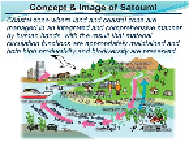Geoscience Reference
In-Depth Information
Figure 6.1
Depiction of
satoumi
, including connections between land and sea
Unlike many other management practices based on traditional cultural heritage,
satoumi
has been incorporated into Japanese national policies, including the Strategy for an Envir-
onmental Nation in the 21st Century (2007), the Third National Biodiversity Strategy of
Japan (2007), and the Basic Plan on Ocean Policy (2008). The concept is being put into
practice through a programme of the Japanese Ministry of Environment, which supports
the efforts of local governments, residents, non-profit organizations, and universities to un-
dertake diverse activities that include planting eelgrass to restore coastal ecosystems, re-
planting of forest in watershed areas, sustainable cultivation of oysters, public education,
and working with fishing communities to revive traditional fishing methods.
These examples demonstrate that the indigenous view of interconnectedness between
water, land, sea, and human cultures exists in many places, and its holistic nature is con-
sistent with the recent emphasis on the ecosystem approach in international environmental
policy. According to the CBD ecosystem approach, management should be decentralized
to the lowest possible level (Principle 2). This would imply that communities are lead pro-
ponents in implementation of the ecosystem approach, as is the case within the context of
traditional resourcemanagement. Governments adoptingtheecosystem approachasacent-
ral component of their national biodiversity and environmental strategies can benefit to a
great degree from the contribution of traditional management practices in its implementa-
tion.
Although traditional knowledge and the ecosystem approach are generally compat-
ible, the fit is not always perfect. Not every aspect of traditional bio-cultural heritage can

